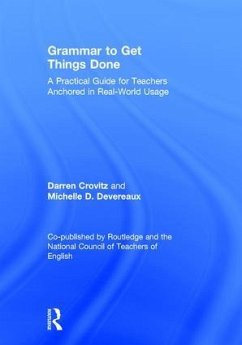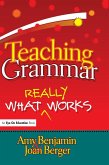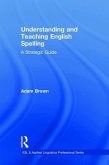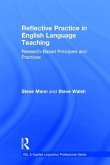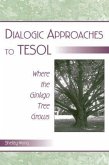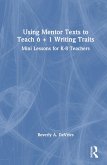Darren Crovitz, Michelle D Devereaux
Grammar to Get Things Done
A Practical Guide for Teachers Anchored in Real-World Usage
Darren Crovitz, Michelle D Devereaux
Grammar to Get Things Done
A Practical Guide for Teachers Anchored in Real-World Usage
- Gebundenes Buch
- Merkliste
- Auf die Merkliste
- Bewerten Bewerten
- Teilen
- Produkt teilen
- Produkterinnerung
- Produkterinnerung
Designed for middle and secondary pre-service and in-service English teachers, this text offers a fresh lens on grammar and grammar instruction. It shows how form, function, and use can help teachers move away from decontextualized grammar instruction and begin considering grammar in applied contexts of everyday use. An important feature is attention to the history of and current attitudes about grammar through a sociocultural lens, with ideas for teachers to bring discussions of language-as-power into their own classrooms.
Andere Kunden interessierten sich auch für
![Teaching Grammar Teaching Grammar]() Amy BenjaminTeaching Grammar140,99 €
Amy BenjaminTeaching Grammar140,99 €![Building Literacy Through Pop Culture in the Ela Classroom Building Literacy Through Pop Culture in the Ela Classroom]() Jen McconnelBuilding Literacy Through Pop Culture in the Ela Classroom176,99 €
Jen McconnelBuilding Literacy Through Pop Culture in the Ela Classroom176,99 €![Pursuing Language and Metalinguistics in K-12 Classrooms Pursuing Language and Metalinguistics in K-12 Classrooms]() Renata Love JonesPursuing Language and Metalinguistics in K-12 Classrooms176,99 €
Renata Love JonesPursuing Language and Metalinguistics in K-12 Classrooms176,99 €![Understanding and Teaching English Spelling Understanding and Teaching English Spelling]() Adam BrownUnderstanding and Teaching English Spelling181,99 €
Adam BrownUnderstanding and Teaching English Spelling181,99 €![Reflective Practice in English Language Teaching Reflective Practice in English Language Teaching]() Steve MannReflective Practice in English Language Teaching180,99 €
Steve MannReflective Practice in English Language Teaching180,99 €![Dialogic Approaches to TESOL Dialogic Approaches to TESOL]() Shelley WongDialogic Approaches to TESOL187,99 €
Shelley WongDialogic Approaches to TESOL187,99 €![Using Mentor Texts to Teach 6 + 1 Writing Traits Using Mentor Texts to Teach 6 + 1 Writing Traits]() Beverly A DeVriesUsing Mentor Texts to Teach 6 + 1 Writing Traits123,99 €
Beverly A DeVriesUsing Mentor Texts to Teach 6 + 1 Writing Traits123,99 €-
-
-
Designed for middle and secondary pre-service and in-service English teachers, this text offers a fresh lens on grammar and grammar instruction. It shows how form, function, and use can help teachers move away from decontextualized grammar instruction and begin considering grammar in applied contexts of everyday use. An important feature is attention to the history of and current attitudes about grammar through a sociocultural lens, with ideas for teachers to bring discussions of language-as-power into their own classrooms.
Hinweis: Dieser Artikel kann nur an eine deutsche Lieferadresse ausgeliefert werden.
Hinweis: Dieser Artikel kann nur an eine deutsche Lieferadresse ausgeliefert werden.
Produktdetails
- Produktdetails
- Verlag: Taylor & Francis
- Seitenzahl: 232
- Erscheinungstermin: 10. November 2016
- Englisch
- Abmessung: 257mm x 183mm x 20mm
- Gewicht: 635g
- ISBN-13: 9781138683693
- ISBN-10: 1138683698
- Artikelnr.: 47518676
- Herstellerkennzeichnung
- Libri GmbH
- Europaallee 1
- 36244 Bad Hersfeld
- gpsr@libri.de
- Verlag: Taylor & Francis
- Seitenzahl: 232
- Erscheinungstermin: 10. November 2016
- Englisch
- Abmessung: 257mm x 183mm x 20mm
- Gewicht: 635g
- ISBN-13: 9781138683693
- ISBN-10: 1138683698
- Artikelnr.: 47518676
- Herstellerkennzeichnung
- Libri GmbH
- Europaallee 1
- 36244 Bad Hersfeld
- gpsr@libri.de
Darren Crovitz is Professor of English and English Education and the Director of English Education at Kennesaw State University, USA. Michelle D. Devereaux is Assistant Professor of English and English Education at Kennesaw State University, USA.
Preface
Acknowledgments
Chapter One: Introduction
Defining Grammar
Grammar
Usage
Mechanics
A Very Short History of Grammar and Usage in the English Language
A Very Short History of Modern Grammar Instruction
Approaches to Grammar: Prescriptive, Descriptive, and Rhetorical
Prescriptive and Descriptive Grammars
Rhetorical Grammar
How We Address Grammar(s) in This Book
Why Definitions?
Form, Function, and Use
Parts of Speech or Lexical Categories?
The Goal For All: Metalinguistic Awareness
References
Chapter Two: Grammar and Power
What is Standard English?
Moralizing Language
Grammar(s) and Power, Society, and Identity
Power
Society
Identity
Critical Awareness and Grammar Instruction
Further Reading
References
Chapter Three: Teaching Grammar Intentionally
Grammar as an Integrated Element of Broader Design
Authority, Control, and Punishment (Sample Integrated Unit #1)
Specific Grammar Concepts for This Unit
Passive (and Active) Voice
Sentence Modifiers: Absolute Phrases
What Counts as Intelligence (Sample Integrated Unit #2)
Specific Grammar Concepts for This Unit
"To Be" Verbs and Sentence Forms
Complex Sentence Structures
How to Plan for Specific Grammar Integration
Correction and Grammar Instruction: Using Student Work Diagnostically
General Issues and What They Mean
Passage- and Paragraph-Level Patterns and What They Mean
Choppy
Awkward or Disorganized
Vague or Underdeveloped
Context Unclear
Redundant
Wordy
Sentence-Level Patterns and What They Mean
Run-Ons, Splices, and Fragments
Agreement Issues
Word Choice
Punctuation Issues
Conclusion
References
Chapter Four: Grammatical Concepts
Introduction: What It Is, and What It Ain't
Structure of Chapter Four
Limitations of Chapter Four
Unit One: Sentences and Sentence Types
The Sentence
Overview
Form and Function
Typical Form Exercises
Focusing on Use: How Sentences are Useful in Actual Communication
Experimenting with the Sentence
Scenario 1: Food Fight
Scenario 2: Gotta Get That Money
Scenario 3: Different Kinds of Bosses
Non-Sentences and Their Uses
Overview
Form
Fragments and Function
Single Words
Phrases and Other Phenomena
Clauses
Fragments in Use
Run-ons and Function
Run-ons in Use
Typical Form Exercises
Focusing on Use: How Non-Sentences are Useful in Actual Communication
Experimenting with Fragments and Run-Ons
Scenario 1: Ghost Stories
Scenario 2: Thirty Seconds of Face Time
Scenario 3: Advertising Your Town
Scenario 4: Remixing the Mocking Run-On
Simple Sentences
Overview
Form
Function
Typical Form Exercises
Focusing on Use: How Simple Sentences are Useful in Actual Communication
Experimenting with Simple Sentences
Scenario 1: Testify
Scenario 2: Honest and Direct
Scenario 3: A Real Apology
Scenario 4: Ending a Relationship
Compound Sentences and Conjunctions
Overview
Form
Function
Yet, For, and Nor
Typical Form Exercises
Focusing on Use: How Compound Sentences are Useful in Actual Communication
Experimenting with Compound Sentences
Scenario 1: Justice For All
Scenario 2: Science Fiction Point-Counterpoint
Scenario 3: Making a Deal
Scenario 4: The Ironic "Yet"
Scenario 5: The Memorable Well-Balanced Line
Scenario 6: The Dramatic Reason or Consequence
Complex Sentences
Overview
Form
Function
Typical Form Exercises
Focusing on Use: How Complex Sentences are Useful in Actual Communication
Experimenting with Complex Sentences
Scenario 1: Friday Night Plans
Scenario 2: Carlee's Concoctions
Scenario 3: Spirit Friday
Scenario 4a: Storybook Summarizer
Scenario 4b: Album Blurbs
Compound-Complex Sentences
Overview
Form
Function
Typical Form Exercises
Focusing on Use: How Compound-Complex Sentences are Useful in Actual
Communication
Experimenting with Compound-Complex Sentences
Scenario 1: Junk Food in School
Scenario 2: Whiffleball Guidelines
Scenario 3: Youth Court Judge
Scenario 4: Who's the Winner
Active and Passive Voice
Overview
Form
Verb Form
Function
Typical Form Exercises
Focusing on Use: How Active Voice is Useful in Actual Communication
Focusing on Use: How Passive Voice is Useful in Actual Communication
Avoiding blame or guilt
Emphasizing a different subject for a particular reason
News reporting
Distancing the doer intentionally for political reasons
Experimenting with Passive Voice
Scenario 1: Grandpa's (Formerly) Fine Ride
Scenario 2: Party Post-Mortem
Scenario 3: Fixing Headlines
Scenario 4: Apology or Non-Apology?
Unit Two: Clauses
Dependent Clauses
Overview
Form
Function
Adverbial Clauses
Dependent Clause Relationships
Punctuating Adverbial Clauses
Adjectival Clauses
Punctuating Adjectival Clauses
Nominal Clauses
Subjects
Objects of the Preposition
**A Quick Refresher: Definitions of Direct Objects and Subject
Complements**
Subject Complements
Direct Objects
Typical Form Exercises
Focusing on Use: How Dependent Clauses are Useful in Actual Communication
Experimenting with Dependent Clauses
Specific Function: Concession
Scenario 1a: Lucas Needs Help
Scenario 1b: Pleading For Leniency
Specific Function: Contrast
Scenario 2a: You're Wearing That?!
Scenario 2b: Adopting a Role
Specific Function: Reason
Scenario 3: Let's Make a Deal
Specific Function: Condition
Scenario 4: No More Bankrolling
Unit Three: Phrases
Appositive Phrases
Overview
Form and Function
Punctuation and Appositives
Typical Form Exercises
Focusing on Use: How Appositive Phrases are Useful in Actual Communication
Experimenting with Appositive Phrases
Scenario 1: Exposing the Truth
Scenario 2: Condensing the Details
Scenario 3: Piling on the Description
Participial Phrases
Overview
Form
Function
Punctuation and Participial Phrases
Typical Form Exercises
Focusing on Use: How Participials are Useful in Actual Communication
Implication
Specificity
Causation
Experimenting with Participial Phrases
Scenario 1: Game Designer
Scenario 2: Stage Director
Scenario 3: The Impact of Experience
Scenario 4a: Helping People Make the Connection, Part 1
Scenario 4b: Helping People Make the Connection, Part 2
Absolute Phrases
Overview
Form
What to Remember
Function
Explaining a Cause or Condition
Adding Detail or a Focal Point
Typical Form Exercises
Focusing on Use: How Absolute Phrases are Useful in Actual Communication
Experimenting with Absolute Phrases
Scenario 1: Game Designer
Scenario 2: Encounter with Fame (A Celebrity, Politician, or Athlete)
Scenario 3: Moment of Growth
Gerunds
Overview
Form
Function
Typical Form Exercises
Focusing on Use: How Gerunds are Useful in Actual Communication
Experimenting with Gerunds
Scenario 1: Xtreme Adventures
Scenario 2: Viral Meme Creation
Scenario 3: Helping the Noobs
Infinitives
Overview
Form
Dangling Infinitives
Function
Infinitives as Adjectives
Infinitives as Adverbs
Infinitives as Nouns
Typical Form Exercises
Focusing on Use: How Infinitives are Useful in Actual Communication
Experimenting with Infinitives
Scenario 1: Sometimes Tentative is Good
Scenario 2: The Villain's Speech
Scenario 3: The Artist Inside
Prepositions
Overview
Form
The Prepositional Phrase
Common Prepositions
Function
Adverbially and Adjectivally
Prepositions or Subordinating Conjunctions?
Never End a Sentence With a Preposition...
Typical Form Exercises
Focusing on Use: How Prepositions are Useful in Actual Communication
Experimenting with Prepositions
Scenario 1a: The Secret Party
Scenario 1b: The Virtual Reality Challenge
Scenario 2: How to Respond?
Scenario 3: The Suggestive Title
Unit Four: Lexical Categories
Nouns
Overview
Form
Function
Subjects
Objects of the Preposition
Direct Objects
Indirect Objects
Object Complements
Subject Complements
Typical Form Exercises
Focusing on Use: How Nouns are Useful in Actual Communication
Nominalization
Noun Versatility
Adjectives Acting as Nouns
Verbs Acting as Nouns
Experimenting with Nouns
Scenario 1: Titles That Pop
Scenario 2: The Power of Summary
Scenario 3: A Primer for Beginners
Action Verbs
Overview
Form and Function
Typical Form Exercises
Focusing on Use: How Action Verbs are Useful in Actual Communication
Verbs for Precision and Connotation
Atypical Verbs and Their Possibilities
Proper Nouns Used as Verbs
Experimenting with Action Verbs
Scenario 1: Communicating the Intangibles
Scenario 2: Degrees of Exaggeration and Understatement
Scenario 3: Meme Hunting
Scenario 4: Energetic Film Titles
Scenario 5a: Sports Writing
Scenario 5b: Reporting on a Sporting Event
Scenario 5c: Researching Sports Reporting Language
Other Verbs
Overview
Form
Active Verbs: Transitive and Intransitive
Transitive Verbs and Direct Objects
Transitive Verbs and Indirect Objects
Intransitive Verbs
Linking Verbs
Modals (one type of Helping Verb)
Function
Typical Form Exercises
Focusing on Use: How Verbs are Useful in Actual Communication
Experimenting with Other Verbs
Scenario 1: Remixing Slogans
Scenario 2: Careful with Advice
Scenario 3: Softening the Criticism
Adjectives
Overview
Form
Comparative and Superlative Forms of Adjectives (Gradable Adjectives)
Funner, or More Fun?
Function
Subject Complements
Object Complements
Typical Form Exercises
Focusing on Use: How Adjectives are Useful in Actual Communication
Moving from Adjectives to Participles (Academic Language)
Converting Adjectives to Action Verbs
Getting More Precise
Proper Nouns as Adjectives
Experimenting with Adjectives
Scenario 1: Wild Water
Scenario 2: Family Style
Scenario 3: Saucy Business
Adverbs
Overview
Form and Function
Adverbs of Manner
Adverbs of Place
Adverbs of Frequency
Adverbs of Time
Adverbs of Purpose
Adverbs of Condition
Modifying More Than Verbs
Typical Form Exercises
Focusing on Use: How Adverbs are Useful in Actual Communication
Experimenting with Adverbs
Scenario 1: Science Lab with Chet
Scenario 2: Refining Your Career Interests
Scenario 3: Kebe is So Mysterious
Scenario 4: It's Over
Pronouns
Overview
Form
Personal Pronouns
Its and It's, Me and I
Demonstrative Pronouns
Reciprocal Pronouns
Interrogative Pronouns
Indefinite Pronouns
Reflexive Pronouns
Relative Pronouns
The Trouble with Whom
Function
Typical Form Exercises
Focusing on Use: How Pronouns are Useful in Actual Communication
Repetition, Tone, and Voice
Determiners
Experimenting with Pronouns
Scenario 1: Bringing the People Together
Scenario 2: Updating the Creed
Scenario 3: Shaping the Scene
Unit Five: Punctuation
Colons
Overview
Form and Function
Colon Function #1
Colon Function #2
Typical Form Exercises
Focusing on Use: How Colons are Useful in Actual Communication
Experimenting with Colons
Scenario 1: The Power of Lists
Scenario 2: Defining a Term
Scenario 3: The Final Reason
Semicolons
Overview
Form and Function
Semicolon Function #1
Semicolon Function #2
Semicolon Function #3
Typical Form Exercises
Focusing on Use: How Semicolons are Useful in Actual Communication
Experimenting with Semicolons
Scenario 1: Deep Dive Into Detail
Scenario 2: Defending Your Honor
Scenario 3: Elaborating on an Idea
Scenario 4: Analyzing Political Posturing
Dashes
Overview
Form
Dashes and Parentheses
Dashes and Dialogue
Dashes vs Hyphens
Function
Typical Form Exercises
Focusing on Use: How Dashes are Useful in Actual Communication
Experimenting with Dashes
Scenario 1: Recreating the Moment
Scenario 2: It's All in the Details
Scenario 3: Defending Donnie
Hyphens
Overview
Form
Function
Modifying Nouns
Connecting Numbers
Describing Age
Joining Words to Create a New Concept
Adding Affixes
Hyphen Caveats
Typical Form Exercises
Focusing on Use: How Hyphens are Useful in Actual Communication
Experimenting with Hyphens
Scenario 1: Harry Hates Hyphens
Scenario 2: Destroying Some Stereotypes
Scenario 3: Gaming Lingo
Commas
Overview
Form and Function
Specific Comma Functions
References
Appendix
Innate Understandings
Suffixes
Grammar Rants
Language and Power
Language and Society/Language and Identity
Grammar(s) of Their Worlds
Open and Closed Word Classes
Analyzing Grammar in Chunks
Punctuation
More Thematic Units
References
Acknowledgments
Chapter One: Introduction
Defining Grammar
Grammar
Usage
Mechanics
A Very Short History of Grammar and Usage in the English Language
A Very Short History of Modern Grammar Instruction
Approaches to Grammar: Prescriptive, Descriptive, and Rhetorical
Prescriptive and Descriptive Grammars
Rhetorical Grammar
How We Address Grammar(s) in This Book
Why Definitions?
Form, Function, and Use
Parts of Speech or Lexical Categories?
The Goal For All: Metalinguistic Awareness
References
Chapter Two: Grammar and Power
What is Standard English?
Moralizing Language
Grammar(s) and Power, Society, and Identity
Power
Society
Identity
Critical Awareness and Grammar Instruction
Further Reading
References
Chapter Three: Teaching Grammar Intentionally
Grammar as an Integrated Element of Broader Design
Authority, Control, and Punishment (Sample Integrated Unit #1)
Specific Grammar Concepts for This Unit
Passive (and Active) Voice
Sentence Modifiers: Absolute Phrases
What Counts as Intelligence (Sample Integrated Unit #2)
Specific Grammar Concepts for This Unit
"To Be" Verbs and Sentence Forms
Complex Sentence Structures
How to Plan for Specific Grammar Integration
Correction and Grammar Instruction: Using Student Work Diagnostically
General Issues and What They Mean
Passage- and Paragraph-Level Patterns and What They Mean
Choppy
Awkward or Disorganized
Vague or Underdeveloped
Context Unclear
Redundant
Wordy
Sentence-Level Patterns and What They Mean
Run-Ons, Splices, and Fragments
Agreement Issues
Word Choice
Punctuation Issues
Conclusion
References
Chapter Four: Grammatical Concepts
Introduction: What It Is, and What It Ain't
Structure of Chapter Four
Limitations of Chapter Four
Unit One: Sentences and Sentence Types
The Sentence
Overview
Form and Function
Typical Form Exercises
Focusing on Use: How Sentences are Useful in Actual Communication
Experimenting with the Sentence
Scenario 1: Food Fight
Scenario 2: Gotta Get That Money
Scenario 3: Different Kinds of Bosses
Non-Sentences and Their Uses
Overview
Form
Fragments and Function
Single Words
Phrases and Other Phenomena
Clauses
Fragments in Use
Run-ons and Function
Run-ons in Use
Typical Form Exercises
Focusing on Use: How Non-Sentences are Useful in Actual Communication
Experimenting with Fragments and Run-Ons
Scenario 1: Ghost Stories
Scenario 2: Thirty Seconds of Face Time
Scenario 3: Advertising Your Town
Scenario 4: Remixing the Mocking Run-On
Simple Sentences
Overview
Form
Function
Typical Form Exercises
Focusing on Use: How Simple Sentences are Useful in Actual Communication
Experimenting with Simple Sentences
Scenario 1: Testify
Scenario 2: Honest and Direct
Scenario 3: A Real Apology
Scenario 4: Ending a Relationship
Compound Sentences and Conjunctions
Overview
Form
Function
Yet, For, and Nor
Typical Form Exercises
Focusing on Use: How Compound Sentences are Useful in Actual Communication
Experimenting with Compound Sentences
Scenario 1: Justice For All
Scenario 2: Science Fiction Point-Counterpoint
Scenario 3: Making a Deal
Scenario 4: The Ironic "Yet"
Scenario 5: The Memorable Well-Balanced Line
Scenario 6: The Dramatic Reason or Consequence
Complex Sentences
Overview
Form
Function
Typical Form Exercises
Focusing on Use: How Complex Sentences are Useful in Actual Communication
Experimenting with Complex Sentences
Scenario 1: Friday Night Plans
Scenario 2: Carlee's Concoctions
Scenario 3: Spirit Friday
Scenario 4a: Storybook Summarizer
Scenario 4b: Album Blurbs
Compound-Complex Sentences
Overview
Form
Function
Typical Form Exercises
Focusing on Use: How Compound-Complex Sentences are Useful in Actual
Communication
Experimenting with Compound-Complex Sentences
Scenario 1: Junk Food in School
Scenario 2: Whiffleball Guidelines
Scenario 3: Youth Court Judge
Scenario 4: Who's the Winner
Active and Passive Voice
Overview
Form
Verb Form
Function
Typical Form Exercises
Focusing on Use: How Active Voice is Useful in Actual Communication
Focusing on Use: How Passive Voice is Useful in Actual Communication
Avoiding blame or guilt
Emphasizing a different subject for a particular reason
News reporting
Distancing the doer intentionally for political reasons
Experimenting with Passive Voice
Scenario 1: Grandpa's (Formerly) Fine Ride
Scenario 2: Party Post-Mortem
Scenario 3: Fixing Headlines
Scenario 4: Apology or Non-Apology?
Unit Two: Clauses
Dependent Clauses
Overview
Form
Function
Adverbial Clauses
Dependent Clause Relationships
Punctuating Adverbial Clauses
Adjectival Clauses
Punctuating Adjectival Clauses
Nominal Clauses
Subjects
Objects of the Preposition
**A Quick Refresher: Definitions of Direct Objects and Subject
Complements**
Subject Complements
Direct Objects
Typical Form Exercises
Focusing on Use: How Dependent Clauses are Useful in Actual Communication
Experimenting with Dependent Clauses
Specific Function: Concession
Scenario 1a: Lucas Needs Help
Scenario 1b: Pleading For Leniency
Specific Function: Contrast
Scenario 2a: You're Wearing That?!
Scenario 2b: Adopting a Role
Specific Function: Reason
Scenario 3: Let's Make a Deal
Specific Function: Condition
Scenario 4: No More Bankrolling
Unit Three: Phrases
Appositive Phrases
Overview
Form and Function
Punctuation and Appositives
Typical Form Exercises
Focusing on Use: How Appositive Phrases are Useful in Actual Communication
Experimenting with Appositive Phrases
Scenario 1: Exposing the Truth
Scenario 2: Condensing the Details
Scenario 3: Piling on the Description
Participial Phrases
Overview
Form
Function
Punctuation and Participial Phrases
Typical Form Exercises
Focusing on Use: How Participials are Useful in Actual Communication
Implication
Specificity
Causation
Experimenting with Participial Phrases
Scenario 1: Game Designer
Scenario 2: Stage Director
Scenario 3: The Impact of Experience
Scenario 4a: Helping People Make the Connection, Part 1
Scenario 4b: Helping People Make the Connection, Part 2
Absolute Phrases
Overview
Form
What to Remember
Function
Explaining a Cause or Condition
Adding Detail or a Focal Point
Typical Form Exercises
Focusing on Use: How Absolute Phrases are Useful in Actual Communication
Experimenting with Absolute Phrases
Scenario 1: Game Designer
Scenario 2: Encounter with Fame (A Celebrity, Politician, or Athlete)
Scenario 3: Moment of Growth
Gerunds
Overview
Form
Function
Typical Form Exercises
Focusing on Use: How Gerunds are Useful in Actual Communication
Experimenting with Gerunds
Scenario 1: Xtreme Adventures
Scenario 2: Viral Meme Creation
Scenario 3: Helping the Noobs
Infinitives
Overview
Form
Dangling Infinitives
Function
Infinitives as Adjectives
Infinitives as Adverbs
Infinitives as Nouns
Typical Form Exercises
Focusing on Use: How Infinitives are Useful in Actual Communication
Experimenting with Infinitives
Scenario 1: Sometimes Tentative is Good
Scenario 2: The Villain's Speech
Scenario 3: The Artist Inside
Prepositions
Overview
Form
The Prepositional Phrase
Common Prepositions
Function
Adverbially and Adjectivally
Prepositions or Subordinating Conjunctions?
Never End a Sentence With a Preposition...
Typical Form Exercises
Focusing on Use: How Prepositions are Useful in Actual Communication
Experimenting with Prepositions
Scenario 1a: The Secret Party
Scenario 1b: The Virtual Reality Challenge
Scenario 2: How to Respond?
Scenario 3: The Suggestive Title
Unit Four: Lexical Categories
Nouns
Overview
Form
Function
Subjects
Objects of the Preposition
Direct Objects
Indirect Objects
Object Complements
Subject Complements
Typical Form Exercises
Focusing on Use: How Nouns are Useful in Actual Communication
Nominalization
Noun Versatility
Adjectives Acting as Nouns
Verbs Acting as Nouns
Experimenting with Nouns
Scenario 1: Titles That Pop
Scenario 2: The Power of Summary
Scenario 3: A Primer for Beginners
Action Verbs
Overview
Form and Function
Typical Form Exercises
Focusing on Use: How Action Verbs are Useful in Actual Communication
Verbs for Precision and Connotation
Atypical Verbs and Their Possibilities
Proper Nouns Used as Verbs
Experimenting with Action Verbs
Scenario 1: Communicating the Intangibles
Scenario 2: Degrees of Exaggeration and Understatement
Scenario 3: Meme Hunting
Scenario 4: Energetic Film Titles
Scenario 5a: Sports Writing
Scenario 5b: Reporting on a Sporting Event
Scenario 5c: Researching Sports Reporting Language
Other Verbs
Overview
Form
Active Verbs: Transitive and Intransitive
Transitive Verbs and Direct Objects
Transitive Verbs and Indirect Objects
Intransitive Verbs
Linking Verbs
Modals (one type of Helping Verb)
Function
Typical Form Exercises
Focusing on Use: How Verbs are Useful in Actual Communication
Experimenting with Other Verbs
Scenario 1: Remixing Slogans
Scenario 2: Careful with Advice
Scenario 3: Softening the Criticism
Adjectives
Overview
Form
Comparative and Superlative Forms of Adjectives (Gradable Adjectives)
Funner, or More Fun?
Function
Subject Complements
Object Complements
Typical Form Exercises
Focusing on Use: How Adjectives are Useful in Actual Communication
Moving from Adjectives to Participles (Academic Language)
Converting Adjectives to Action Verbs
Getting More Precise
Proper Nouns as Adjectives
Experimenting with Adjectives
Scenario 1: Wild Water
Scenario 2: Family Style
Scenario 3: Saucy Business
Adverbs
Overview
Form and Function
Adverbs of Manner
Adverbs of Place
Adverbs of Frequency
Adverbs of Time
Adverbs of Purpose
Adverbs of Condition
Modifying More Than Verbs
Typical Form Exercises
Focusing on Use: How Adverbs are Useful in Actual Communication
Experimenting with Adverbs
Scenario 1: Science Lab with Chet
Scenario 2: Refining Your Career Interests
Scenario 3: Kebe is So Mysterious
Scenario 4: It's Over
Pronouns
Overview
Form
Personal Pronouns
Its and It's, Me and I
Demonstrative Pronouns
Reciprocal Pronouns
Interrogative Pronouns
Indefinite Pronouns
Reflexive Pronouns
Relative Pronouns
The Trouble with Whom
Function
Typical Form Exercises
Focusing on Use: How Pronouns are Useful in Actual Communication
Repetition, Tone, and Voice
Determiners
Experimenting with Pronouns
Scenario 1: Bringing the People Together
Scenario 2: Updating the Creed
Scenario 3: Shaping the Scene
Unit Five: Punctuation
Colons
Overview
Form and Function
Colon Function #1
Colon Function #2
Typical Form Exercises
Focusing on Use: How Colons are Useful in Actual Communication
Experimenting with Colons
Scenario 1: The Power of Lists
Scenario 2: Defining a Term
Scenario 3: The Final Reason
Semicolons
Overview
Form and Function
Semicolon Function #1
Semicolon Function #2
Semicolon Function #3
Typical Form Exercises
Focusing on Use: How Semicolons are Useful in Actual Communication
Experimenting with Semicolons
Scenario 1: Deep Dive Into Detail
Scenario 2: Defending Your Honor
Scenario 3: Elaborating on an Idea
Scenario 4: Analyzing Political Posturing
Dashes
Overview
Form
Dashes and Parentheses
Dashes and Dialogue
Dashes vs Hyphens
Function
Typical Form Exercises
Focusing on Use: How Dashes are Useful in Actual Communication
Experimenting with Dashes
Scenario 1: Recreating the Moment
Scenario 2: It's All in the Details
Scenario 3: Defending Donnie
Hyphens
Overview
Form
Function
Modifying Nouns
Connecting Numbers
Describing Age
Joining Words to Create a New Concept
Adding Affixes
Hyphen Caveats
Typical Form Exercises
Focusing on Use: How Hyphens are Useful in Actual Communication
Experimenting with Hyphens
Scenario 1: Harry Hates Hyphens
Scenario 2: Destroying Some Stereotypes
Scenario 3: Gaming Lingo
Commas
Overview
Form and Function
Specific Comma Functions
References
Appendix
Innate Understandings
Suffixes
Grammar Rants
Language and Power
Language and Society/Language and Identity
Grammar(s) of Their Worlds
Open and Closed Word Classes
Analyzing Grammar in Chunks
Punctuation
More Thematic Units
References
Preface
Acknowledgments
Chapter One: Introduction
Defining Grammar
Grammar
Usage
Mechanics
A Very Short History of Grammar and Usage in the English Language
A Very Short History of Modern Grammar Instruction
Approaches to Grammar: Prescriptive, Descriptive, and Rhetorical
Prescriptive and Descriptive Grammars
Rhetorical Grammar
How We Address Grammar(s) in This Book
Why Definitions?
Form, Function, and Use
Parts of Speech or Lexical Categories?
The Goal For All: Metalinguistic Awareness
References
Chapter Two: Grammar and Power
What is Standard English?
Moralizing Language
Grammar(s) and Power, Society, and Identity
Power
Society
Identity
Critical Awareness and Grammar Instruction
Further Reading
References
Chapter Three: Teaching Grammar Intentionally
Grammar as an Integrated Element of Broader Design
Authority, Control, and Punishment (Sample Integrated Unit #1)
Specific Grammar Concepts for This Unit
Passive (and Active) Voice
Sentence Modifiers: Absolute Phrases
What Counts as Intelligence (Sample Integrated Unit #2)
Specific Grammar Concepts for This Unit
"To Be" Verbs and Sentence Forms
Complex Sentence Structures
How to Plan for Specific Grammar Integration
Correction and Grammar Instruction: Using Student Work Diagnostically
General Issues and What They Mean
Passage- and Paragraph-Level Patterns and What They Mean
Choppy
Awkward or Disorganized
Vague or Underdeveloped
Context Unclear
Redundant
Wordy
Sentence-Level Patterns and What They Mean
Run-Ons, Splices, and Fragments
Agreement Issues
Word Choice
Punctuation Issues
Conclusion
References
Chapter Four: Grammatical Concepts
Introduction: What It Is, and What It Ain't
Structure of Chapter Four
Limitations of Chapter Four
Unit One: Sentences and Sentence Types
The Sentence
Overview
Form and Function
Typical Form Exercises
Focusing on Use: How Sentences are Useful in Actual Communication
Experimenting with the Sentence
Scenario 1: Food Fight
Scenario 2: Gotta Get That Money
Scenario 3: Different Kinds of Bosses
Non-Sentences and Their Uses
Overview
Form
Fragments and Function
Single Words
Phrases and Other Phenomena
Clauses
Fragments in Use
Run-ons and Function
Run-ons in Use
Typical Form Exercises
Focusing on Use: How Non-Sentences are Useful in Actual Communication
Experimenting with Fragments and Run-Ons
Scenario 1: Ghost Stories
Scenario 2: Thirty Seconds of Face Time
Scenario 3: Advertising Your Town
Scenario 4: Remixing the Mocking Run-On
Simple Sentences
Overview
Form
Function
Typical Form Exercises
Focusing on Use: How Simple Sentences are Useful in Actual Communication
Experimenting with Simple Sentences
Scenario 1: Testify
Scenario 2: Honest and Direct
Scenario 3: A Real Apology
Scenario 4: Ending a Relationship
Compound Sentences and Conjunctions
Overview
Form
Function
Yet, For, and Nor
Typical Form Exercises
Focusing on Use: How Compound Sentences are Useful in Actual Communication
Experimenting with Compound Sentences
Scenario 1: Justice For All
Scenario 2: Science Fiction Point-Counterpoint
Scenario 3: Making a Deal
Scenario 4: The Ironic "Yet"
Scenario 5: The Memorable Well-Balanced Line
Scenario 6: The Dramatic Reason or Consequence
Complex Sentences
Overview
Form
Function
Typical Form Exercises
Focusing on Use: How Complex Sentences are Useful in Actual Communication
Experimenting with Complex Sentences
Scenario 1: Friday Night Plans
Scenario 2: Carlee's Concoctions
Scenario 3: Spirit Friday
Scenario 4a: Storybook Summarizer
Scenario 4b: Album Blurbs
Compound-Complex Sentences
Overview
Form
Function
Typical Form Exercises
Focusing on Use: How Compound-Complex Sentences are Useful in Actual
Communication
Experimenting with Compound-Complex Sentences
Scenario 1: Junk Food in School
Scenario 2: Whiffleball Guidelines
Scenario 3: Youth Court Judge
Scenario 4: Who's the Winner
Active and Passive Voice
Overview
Form
Verb Form
Function
Typical Form Exercises
Focusing on Use: How Active Voice is Useful in Actual Communication
Focusing on Use: How Passive Voice is Useful in Actual Communication
Avoiding blame or guilt
Emphasizing a different subject for a particular reason
News reporting
Distancing the doer intentionally for political reasons
Experimenting with Passive Voice
Scenario 1: Grandpa's (Formerly) Fine Ride
Scenario 2: Party Post-Mortem
Scenario 3: Fixing Headlines
Scenario 4: Apology or Non-Apology?
Unit Two: Clauses
Dependent Clauses
Overview
Form
Function
Adverbial Clauses
Dependent Clause Relationships
Punctuating Adverbial Clauses
Adjectival Clauses
Punctuating Adjectival Clauses
Nominal Clauses
Subjects
Objects of the Preposition
**A Quick Refresher: Definitions of Direct Objects and Subject
Complements**
Subject Complements
Direct Objects
Typical Form Exercises
Focusing on Use: How Dependent Clauses are Useful in Actual Communication
Experimenting with Dependent Clauses
Specific Function: Concession
Scenario 1a: Lucas Needs Help
Scenario 1b: Pleading For Leniency
Specific Function: Contrast
Scenario 2a: You're Wearing That?!
Scenario 2b: Adopting a Role
Specific Function: Reason
Scenario 3: Let's Make a Deal
Specific Function: Condition
Scenario 4: No More Bankrolling
Unit Three: Phrases
Appositive Phrases
Overview
Form and Function
Punctuation and Appositives
Typical Form Exercises
Focusing on Use: How Appositive Phrases are Useful in Actual Communication
Experimenting with Appositive Phrases
Scenario 1: Exposing the Truth
Scenario 2: Condensing the Details
Scenario 3: Piling on the Description
Participial Phrases
Overview
Form
Function
Punctuation and Participial Phrases
Typical Form Exercises
Focusing on Use: How Participials are Useful in Actual Communication
Implication
Specificity
Causation
Experimenting with Participial Phrases
Scenario 1: Game Designer
Scenario 2: Stage Director
Scenario 3: The Impact of Experience
Scenario 4a: Helping People Make the Connection, Part 1
Scenario 4b: Helping People Make the Connection, Part 2
Absolute Phrases
Overview
Form
What to Remember
Function
Explaining a Cause or Condition
Adding Detail or a Focal Point
Typical Form Exercises
Focusing on Use: How Absolute Phrases are Useful in Actual Communication
Experimenting with Absolute Phrases
Scenario 1: Game Designer
Scenario 2: Encounter with Fame (A Celebrity, Politician, or Athlete)
Scenario 3: Moment of Growth
Gerunds
Overview
Form
Function
Typical Form Exercises
Focusing on Use: How Gerunds are Useful in Actual Communication
Experimenting with Gerunds
Scenario 1: Xtreme Adventures
Scenario 2: Viral Meme Creation
Scenario 3: Helping the Noobs
Infinitives
Overview
Form
Dangling Infinitives
Function
Infinitives as Adjectives
Infinitives as Adverbs
Infinitives as Nouns
Typical Form Exercises
Focusing on Use: How Infinitives are Useful in Actual Communication
Experimenting with Infinitives
Scenario 1: Sometimes Tentative is Good
Scenario 2: The Villain's Speech
Scenario 3: The Artist Inside
Prepositions
Overview
Form
The Prepositional Phrase
Common Prepositions
Function
Adverbially and Adjectivally
Prepositions or Subordinating Conjunctions?
Never End a Sentence With a Preposition...
Typical Form Exercises
Focusing on Use: How Prepositions are Useful in Actual Communication
Experimenting with Prepositions
Scenario 1a: The Secret Party
Scenario 1b: The Virtual Reality Challenge
Scenario 2: How to Respond?
Scenario 3: The Suggestive Title
Unit Four: Lexical Categories
Nouns
Overview
Form
Function
Subjects
Objects of the Preposition
Direct Objects
Indirect Objects
Object Complements
Subject Complements
Typical Form Exercises
Focusing on Use: How Nouns are Useful in Actual Communication
Nominalization
Noun Versatility
Adjectives Acting as Nouns
Verbs Acting as Nouns
Experimenting with Nouns
Scenario 1: Titles That Pop
Scenario 2: The Power of Summary
Scenario 3: A Primer for Beginners
Action Verbs
Overview
Form and Function
Typical Form Exercises
Focusing on Use: How Action Verbs are Useful in Actual Communication
Verbs for Precision and Connotation
Atypical Verbs and Their Possibilities
Proper Nouns Used as Verbs
Experimenting with Action Verbs
Scenario 1: Communicating the Intangibles
Scenario 2: Degrees of Exaggeration and Understatement
Scenario 3: Meme Hunting
Scenario 4: Energetic Film Titles
Scenario 5a: Sports Writing
Scenario 5b: Reporting on a Sporting Event
Scenario 5c: Researching Sports Reporting Language
Other Verbs
Overview
Form
Active Verbs: Transitive and Intransitive
Transitive Verbs and Direct Objects
Transitive Verbs and Indirect Objects
Intransitive Verbs
Linking Verbs
Modals (one type of Helping Verb)
Function
Typical Form Exercises
Focusing on Use: How Verbs are Useful in Actual Communication
Experimenting with Other Verbs
Scenario 1: Remixing Slogans
Scenario 2: Careful with Advice
Scenario 3: Softening the Criticism
Adjectives
Overview
Form
Comparative and Superlative Forms of Adjectives (Gradable Adjectives)
Funner, or More Fun?
Function
Subject Complements
Object Complements
Typical Form Exercises
Focusing on Use: How Adjectives are Useful in Actual Communication
Moving from Adjectives to Participles (Academic Language)
Converting Adjectives to Action Verbs
Getting More Precise
Proper Nouns as Adjectives
Experimenting with Adjectives
Scenario 1: Wild Water
Scenario 2: Family Style
Scenario 3: Saucy Business
Adverbs
Overview
Form and Function
Adverbs of Manner
Adverbs of Place
Adverbs of Frequency
Adverbs of Time
Adverbs of Purpose
Adverbs of Condition
Modifying More Than Verbs
Typical Form Exercises
Focusing on Use: How Adverbs are Useful in Actual Communication
Experimenting with Adverbs
Scenario 1: Science Lab with Chet
Scenario 2: Refining Your Career Interests
Scenario 3: Kebe is So Mysterious
Scenario 4: It's Over
Pronouns
Overview
Form
Personal Pronouns
Its and It's, Me and I
Demonstrative Pronouns
Reciprocal Pronouns
Interrogative Pronouns
Indefinite Pronouns
Reflexive Pronouns
Relative Pronouns
The Trouble with Whom
Function
Typical Form Exercises
Focusing on Use: How Pronouns are Useful in Actual Communication
Repetition, Tone, and Voice
Determiners
Experimenting with Pronouns
Scenario 1: Bringing the People Together
Scenario 2: Updating the Creed
Scenario 3: Shaping the Scene
Unit Five: Punctuation
Colons
Overview
Form and Function
Colon Function #1
Colon Function #2
Typical Form Exercises
Focusing on Use: How Colons are Useful in Actual Communication
Experimenting with Colons
Scenario 1: The Power of Lists
Scenario 2: Defining a Term
Scenario 3: The Final Reason
Semicolons
Overview
Form and Function
Semicolon Function #1
Semicolon Function #2
Semicolon Function #3
Typical Form Exercises
Focusing on Use: How Semicolons are Useful in Actual Communication
Experimenting with Semicolons
Scenario 1: Deep Dive Into Detail
Scenario 2: Defending Your Honor
Scenario 3: Elaborating on an Idea
Scenario 4: Analyzing Political Posturing
Dashes
Overview
Form
Dashes and Parentheses
Dashes and Dialogue
Dashes vs Hyphens
Function
Typical Form Exercises
Focusing on Use: How Dashes are Useful in Actual Communication
Experimenting with Dashes
Scenario 1: Recreating the Moment
Scenario 2: It's All in the Details
Scenario 3: Defending Donnie
Hyphens
Overview
Form
Function
Modifying Nouns
Connecting Numbers
Describing Age
Joining Words to Create a New Concept
Adding Affixes
Hyphen Caveats
Typical Form Exercises
Focusing on Use: How Hyphens are Useful in Actual Communication
Experimenting with Hyphens
Scenario 1: Harry Hates Hyphens
Scenario 2: Destroying Some Stereotypes
Scenario 3: Gaming Lingo
Commas
Overview
Form and Function
Specific Comma Functions
References
Appendix
Innate Understandings
Suffixes
Grammar Rants
Language and Power
Language and Society/Language and Identity
Grammar(s) of Their Worlds
Open and Closed Word Classes
Analyzing Grammar in Chunks
Punctuation
More Thematic Units
References
Acknowledgments
Chapter One: Introduction
Defining Grammar
Grammar
Usage
Mechanics
A Very Short History of Grammar and Usage in the English Language
A Very Short History of Modern Grammar Instruction
Approaches to Grammar: Prescriptive, Descriptive, and Rhetorical
Prescriptive and Descriptive Grammars
Rhetorical Grammar
How We Address Grammar(s) in This Book
Why Definitions?
Form, Function, and Use
Parts of Speech or Lexical Categories?
The Goal For All: Metalinguistic Awareness
References
Chapter Two: Grammar and Power
What is Standard English?
Moralizing Language
Grammar(s) and Power, Society, and Identity
Power
Society
Identity
Critical Awareness and Grammar Instruction
Further Reading
References
Chapter Three: Teaching Grammar Intentionally
Grammar as an Integrated Element of Broader Design
Authority, Control, and Punishment (Sample Integrated Unit #1)
Specific Grammar Concepts for This Unit
Passive (and Active) Voice
Sentence Modifiers: Absolute Phrases
What Counts as Intelligence (Sample Integrated Unit #2)
Specific Grammar Concepts for This Unit
"To Be" Verbs and Sentence Forms
Complex Sentence Structures
How to Plan for Specific Grammar Integration
Correction and Grammar Instruction: Using Student Work Diagnostically
General Issues and What They Mean
Passage- and Paragraph-Level Patterns and What They Mean
Choppy
Awkward or Disorganized
Vague or Underdeveloped
Context Unclear
Redundant
Wordy
Sentence-Level Patterns and What They Mean
Run-Ons, Splices, and Fragments
Agreement Issues
Word Choice
Punctuation Issues
Conclusion
References
Chapter Four: Grammatical Concepts
Introduction: What It Is, and What It Ain't
Structure of Chapter Four
Limitations of Chapter Four
Unit One: Sentences and Sentence Types
The Sentence
Overview
Form and Function
Typical Form Exercises
Focusing on Use: How Sentences are Useful in Actual Communication
Experimenting with the Sentence
Scenario 1: Food Fight
Scenario 2: Gotta Get That Money
Scenario 3: Different Kinds of Bosses
Non-Sentences and Their Uses
Overview
Form
Fragments and Function
Single Words
Phrases and Other Phenomena
Clauses
Fragments in Use
Run-ons and Function
Run-ons in Use
Typical Form Exercises
Focusing on Use: How Non-Sentences are Useful in Actual Communication
Experimenting with Fragments and Run-Ons
Scenario 1: Ghost Stories
Scenario 2: Thirty Seconds of Face Time
Scenario 3: Advertising Your Town
Scenario 4: Remixing the Mocking Run-On
Simple Sentences
Overview
Form
Function
Typical Form Exercises
Focusing on Use: How Simple Sentences are Useful in Actual Communication
Experimenting with Simple Sentences
Scenario 1: Testify
Scenario 2: Honest and Direct
Scenario 3: A Real Apology
Scenario 4: Ending a Relationship
Compound Sentences and Conjunctions
Overview
Form
Function
Yet, For, and Nor
Typical Form Exercises
Focusing on Use: How Compound Sentences are Useful in Actual Communication
Experimenting with Compound Sentences
Scenario 1: Justice For All
Scenario 2: Science Fiction Point-Counterpoint
Scenario 3: Making a Deal
Scenario 4: The Ironic "Yet"
Scenario 5: The Memorable Well-Balanced Line
Scenario 6: The Dramatic Reason or Consequence
Complex Sentences
Overview
Form
Function
Typical Form Exercises
Focusing on Use: How Complex Sentences are Useful in Actual Communication
Experimenting with Complex Sentences
Scenario 1: Friday Night Plans
Scenario 2: Carlee's Concoctions
Scenario 3: Spirit Friday
Scenario 4a: Storybook Summarizer
Scenario 4b: Album Blurbs
Compound-Complex Sentences
Overview
Form
Function
Typical Form Exercises
Focusing on Use: How Compound-Complex Sentences are Useful in Actual
Communication
Experimenting with Compound-Complex Sentences
Scenario 1: Junk Food in School
Scenario 2: Whiffleball Guidelines
Scenario 3: Youth Court Judge
Scenario 4: Who's the Winner
Active and Passive Voice
Overview
Form
Verb Form
Function
Typical Form Exercises
Focusing on Use: How Active Voice is Useful in Actual Communication
Focusing on Use: How Passive Voice is Useful in Actual Communication
Avoiding blame or guilt
Emphasizing a different subject for a particular reason
News reporting
Distancing the doer intentionally for political reasons
Experimenting with Passive Voice
Scenario 1: Grandpa's (Formerly) Fine Ride
Scenario 2: Party Post-Mortem
Scenario 3: Fixing Headlines
Scenario 4: Apology or Non-Apology?
Unit Two: Clauses
Dependent Clauses
Overview
Form
Function
Adverbial Clauses
Dependent Clause Relationships
Punctuating Adverbial Clauses
Adjectival Clauses
Punctuating Adjectival Clauses
Nominal Clauses
Subjects
Objects of the Preposition
**A Quick Refresher: Definitions of Direct Objects and Subject
Complements**
Subject Complements
Direct Objects
Typical Form Exercises
Focusing on Use: How Dependent Clauses are Useful in Actual Communication
Experimenting with Dependent Clauses
Specific Function: Concession
Scenario 1a: Lucas Needs Help
Scenario 1b: Pleading For Leniency
Specific Function: Contrast
Scenario 2a: You're Wearing That?!
Scenario 2b: Adopting a Role
Specific Function: Reason
Scenario 3: Let's Make a Deal
Specific Function: Condition
Scenario 4: No More Bankrolling
Unit Three: Phrases
Appositive Phrases
Overview
Form and Function
Punctuation and Appositives
Typical Form Exercises
Focusing on Use: How Appositive Phrases are Useful in Actual Communication
Experimenting with Appositive Phrases
Scenario 1: Exposing the Truth
Scenario 2: Condensing the Details
Scenario 3: Piling on the Description
Participial Phrases
Overview
Form
Function
Punctuation and Participial Phrases
Typical Form Exercises
Focusing on Use: How Participials are Useful in Actual Communication
Implication
Specificity
Causation
Experimenting with Participial Phrases
Scenario 1: Game Designer
Scenario 2: Stage Director
Scenario 3: The Impact of Experience
Scenario 4a: Helping People Make the Connection, Part 1
Scenario 4b: Helping People Make the Connection, Part 2
Absolute Phrases
Overview
Form
What to Remember
Function
Explaining a Cause or Condition
Adding Detail or a Focal Point
Typical Form Exercises
Focusing on Use: How Absolute Phrases are Useful in Actual Communication
Experimenting with Absolute Phrases
Scenario 1: Game Designer
Scenario 2: Encounter with Fame (A Celebrity, Politician, or Athlete)
Scenario 3: Moment of Growth
Gerunds
Overview
Form
Function
Typical Form Exercises
Focusing on Use: How Gerunds are Useful in Actual Communication
Experimenting with Gerunds
Scenario 1: Xtreme Adventures
Scenario 2: Viral Meme Creation
Scenario 3: Helping the Noobs
Infinitives
Overview
Form
Dangling Infinitives
Function
Infinitives as Adjectives
Infinitives as Adverbs
Infinitives as Nouns
Typical Form Exercises
Focusing on Use: How Infinitives are Useful in Actual Communication
Experimenting with Infinitives
Scenario 1: Sometimes Tentative is Good
Scenario 2: The Villain's Speech
Scenario 3: The Artist Inside
Prepositions
Overview
Form
The Prepositional Phrase
Common Prepositions
Function
Adverbially and Adjectivally
Prepositions or Subordinating Conjunctions?
Never End a Sentence With a Preposition...
Typical Form Exercises
Focusing on Use: How Prepositions are Useful in Actual Communication
Experimenting with Prepositions
Scenario 1a: The Secret Party
Scenario 1b: The Virtual Reality Challenge
Scenario 2: How to Respond?
Scenario 3: The Suggestive Title
Unit Four: Lexical Categories
Nouns
Overview
Form
Function
Subjects
Objects of the Preposition
Direct Objects
Indirect Objects
Object Complements
Subject Complements
Typical Form Exercises
Focusing on Use: How Nouns are Useful in Actual Communication
Nominalization
Noun Versatility
Adjectives Acting as Nouns
Verbs Acting as Nouns
Experimenting with Nouns
Scenario 1: Titles That Pop
Scenario 2: The Power of Summary
Scenario 3: A Primer for Beginners
Action Verbs
Overview
Form and Function
Typical Form Exercises
Focusing on Use: How Action Verbs are Useful in Actual Communication
Verbs for Precision and Connotation
Atypical Verbs and Their Possibilities
Proper Nouns Used as Verbs
Experimenting with Action Verbs
Scenario 1: Communicating the Intangibles
Scenario 2: Degrees of Exaggeration and Understatement
Scenario 3: Meme Hunting
Scenario 4: Energetic Film Titles
Scenario 5a: Sports Writing
Scenario 5b: Reporting on a Sporting Event
Scenario 5c: Researching Sports Reporting Language
Other Verbs
Overview
Form
Active Verbs: Transitive and Intransitive
Transitive Verbs and Direct Objects
Transitive Verbs and Indirect Objects
Intransitive Verbs
Linking Verbs
Modals (one type of Helping Verb)
Function
Typical Form Exercises
Focusing on Use: How Verbs are Useful in Actual Communication
Experimenting with Other Verbs
Scenario 1: Remixing Slogans
Scenario 2: Careful with Advice
Scenario 3: Softening the Criticism
Adjectives
Overview
Form
Comparative and Superlative Forms of Adjectives (Gradable Adjectives)
Funner, or More Fun?
Function
Subject Complements
Object Complements
Typical Form Exercises
Focusing on Use: How Adjectives are Useful in Actual Communication
Moving from Adjectives to Participles (Academic Language)
Converting Adjectives to Action Verbs
Getting More Precise
Proper Nouns as Adjectives
Experimenting with Adjectives
Scenario 1: Wild Water
Scenario 2: Family Style
Scenario 3: Saucy Business
Adverbs
Overview
Form and Function
Adverbs of Manner
Adverbs of Place
Adverbs of Frequency
Adverbs of Time
Adverbs of Purpose
Adverbs of Condition
Modifying More Than Verbs
Typical Form Exercises
Focusing on Use: How Adverbs are Useful in Actual Communication
Experimenting with Adverbs
Scenario 1: Science Lab with Chet
Scenario 2: Refining Your Career Interests
Scenario 3: Kebe is So Mysterious
Scenario 4: It's Over
Pronouns
Overview
Form
Personal Pronouns
Its and It's, Me and I
Demonstrative Pronouns
Reciprocal Pronouns
Interrogative Pronouns
Indefinite Pronouns
Reflexive Pronouns
Relative Pronouns
The Trouble with Whom
Function
Typical Form Exercises
Focusing on Use: How Pronouns are Useful in Actual Communication
Repetition, Tone, and Voice
Determiners
Experimenting with Pronouns
Scenario 1: Bringing the People Together
Scenario 2: Updating the Creed
Scenario 3: Shaping the Scene
Unit Five: Punctuation
Colons
Overview
Form and Function
Colon Function #1
Colon Function #2
Typical Form Exercises
Focusing on Use: How Colons are Useful in Actual Communication
Experimenting with Colons
Scenario 1: The Power of Lists
Scenario 2: Defining a Term
Scenario 3: The Final Reason
Semicolons
Overview
Form and Function
Semicolon Function #1
Semicolon Function #2
Semicolon Function #3
Typical Form Exercises
Focusing on Use: How Semicolons are Useful in Actual Communication
Experimenting with Semicolons
Scenario 1: Deep Dive Into Detail
Scenario 2: Defending Your Honor
Scenario 3: Elaborating on an Idea
Scenario 4: Analyzing Political Posturing
Dashes
Overview
Form
Dashes and Parentheses
Dashes and Dialogue
Dashes vs Hyphens
Function
Typical Form Exercises
Focusing on Use: How Dashes are Useful in Actual Communication
Experimenting with Dashes
Scenario 1: Recreating the Moment
Scenario 2: It's All in the Details
Scenario 3: Defending Donnie
Hyphens
Overview
Form
Function
Modifying Nouns
Connecting Numbers
Describing Age
Joining Words to Create a New Concept
Adding Affixes
Hyphen Caveats
Typical Form Exercises
Focusing on Use: How Hyphens are Useful in Actual Communication
Experimenting with Hyphens
Scenario 1: Harry Hates Hyphens
Scenario 2: Destroying Some Stereotypes
Scenario 3: Gaming Lingo
Commas
Overview
Form and Function
Specific Comma Functions
References
Appendix
Innate Understandings
Suffixes
Grammar Rants
Language and Power
Language and Society/Language and Identity
Grammar(s) of Their Worlds
Open and Closed Word Classes
Analyzing Grammar in Chunks
Punctuation
More Thematic Units
References

